Training your dog to be comfortable with a crate can be a smooth and rewarding experience. I managed to teach my dog to view their crate as a personal haven where they feel secure and at ease. This approach doesn’t just offer a safe space for my pet; it also promotes good behavior and simplifies house training.
To make the crate more appealing, I often use snacks and their preferred toys to build positive associations. Having a consistent routine has also played a big role in helping my dog feel confident, and now they naturally go to their crate when they need to unwind. I’m keen on sharing these insights to assist fellow pet owners in crate training, aiming to achieve a peaceful living environment and a happy, well-mannered dog.
Essential Tips for Successful Dog Crate Training:
- Start slowly to get your dog used to the crate without causing stress.
- Use encouraging words and treat rewards to associate the crate with positive experiences.
- Keep a regular schedule to build your dog’s confidence and predictability.
- Ensure the crate is comfortable with bedding and safe toys.
- Gradually increase the time your dog spends in the crate.
Incorporating these strategies can lead to a more tranquil and enjoyable living situation for both you and your furry companion.
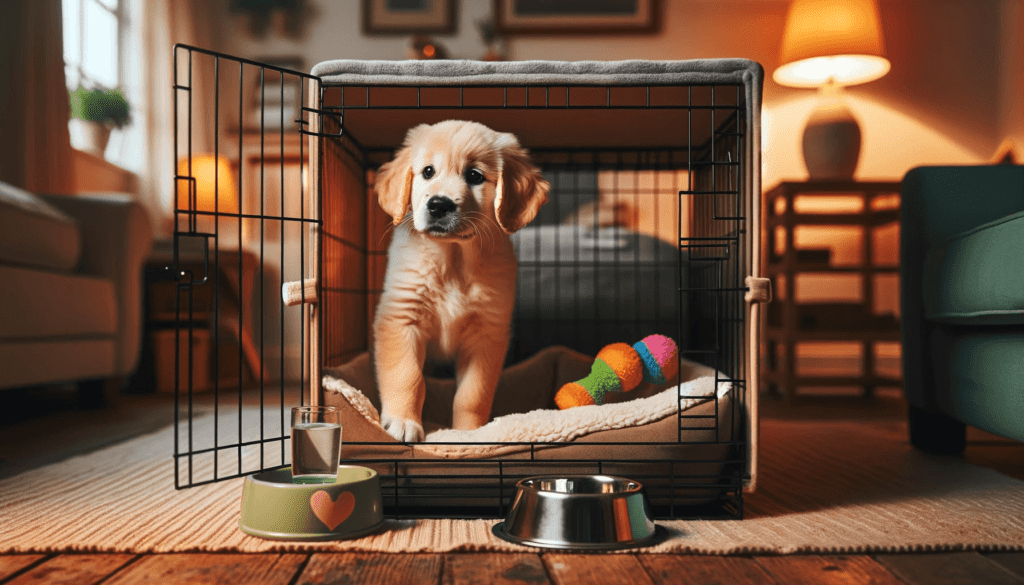
What Does ‘Dog Crate’ Mean?
A dog crate is a secure and private space where you can safely keep your dog for short times. Think of it as their room within your home. Dogs have a natural desire for a den-like area, and a crate can serve that purpose. It’s useful for several things, such as house training, recovering from an injury, or giving your dog a place to relax.
When picking out a crate, I make sure it’s spacious enough for my dog to lie down, stand up, and turn around comfortably. But the size isn’t the only thing that matters; it’s also about ensuring my dog connects the crate with positive experiences. I introduce the crate with treats and cozy bedding, making sure it’s never used as a punishment. By doing this, my dog begins to view the crate as a safe zone, rather than a prison.
- Product Features:
- Robust build
- Adequate size for comfortable movement
- Soft bedding
- Advantages:
- Helps with potty training
- Acts as a secure spot
- Convenient for travel
- Disadvantages:
- Can be an investment
- Misuse might cause stress
- Occupies room in the house
Choosing the right crate is more than just buying a box for your dog—it’s about providing a space that meets their instinctual needs and makes them feel safe. It’s also important to remember that while a crate is a helpful tool, it should be used responsibly to ensure that it remains a positive space for your pup.
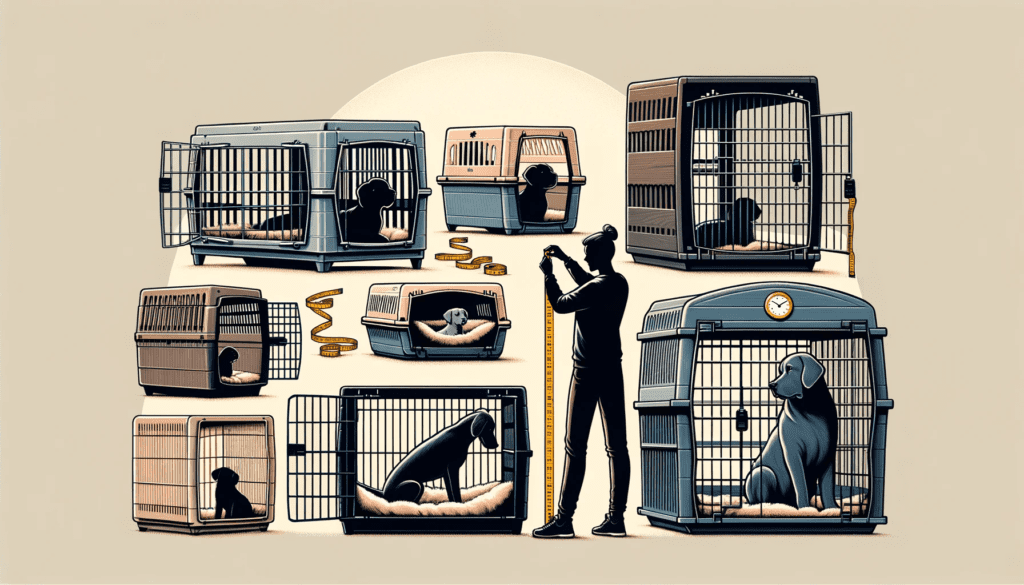

Selecting the Perfect Crate for Dog Create Training
Choosing the Right Dog Crate
When it comes to finding the ideal crate for my pet, size is always the first detail I look into to make sure they have enough space to be comfortable and secure. Getting the crate size right is key – too small, and my dog might feel cramped and stressed, too big, and it won’t feel like the snug space they enjoy.
I take a tape measure and record my dog’s length from their nose to the base of their tail, then add a couple of inches to ensure they have enough room to stretch out and move around.
Picking the perfect crate also means considering what makes my dog feel safe and what suits their behavior. Wire crates are strong and provide good ventilation, which is why they are commonly a preferred choice. However, if travel is on the agenda, or if my dog likes a bit more seclusion, a solid plastic crate is the way to go.
I follow a simple buying guide when it comes to crates: look for secure locks and rounded corners to prevent injuries. The ease of moving the crate is also something I think about; crates that fold up and have handles or wheels are a big help.
If you’re wondering where to get a dog crate, both pet stores and online shops have plenty of options. I make sure to read customer feedback and weigh up the features to pick a good quality crate that meets my pet’s needs.
“Finding the right crate for your dog is not just about buying a box; it’s about giving them a second home where they feel safe.”
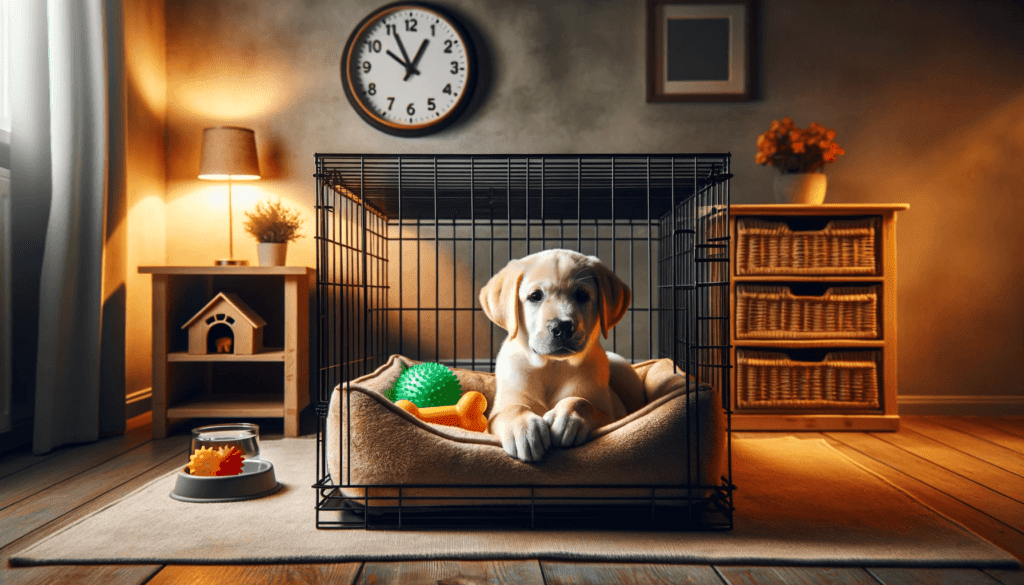

Creating a Safe Haven for Your Dog: The Power of Dog Crate Training
After picking out the ideal crate for my pup, I set about making a crate routine that’s both comforting and secure for them. Starting right with dog crate training is vital. The approach you take to introduce your dog to their crate and the positive experiences you create are what make the training successful.
- I started by putting their much-loved blanket and an item of my clothing inside, which helped to fill the space with smells they recognized.
- Meal times were then had in the crate, reinforcing the idea that this space is theirs.
- We began with short, positive times near the open crate and gradually increased the duration, always ending with plenty of praise.
- When I leave them in the crate, I make sure to stay calm to show them that spending time in the crate is completely normal and not a cause for concern.
These steps form the basics of crate training, whether you’re working with a puppy or an older dog. Through understanding and consistency, I’ve seen my dog become more and more at ease with their crate. Now, we’re all set to move forward with more advanced crate training, building on the strong start we’ve already made.
Remember, creating a safe haven for your dog takes time and love.
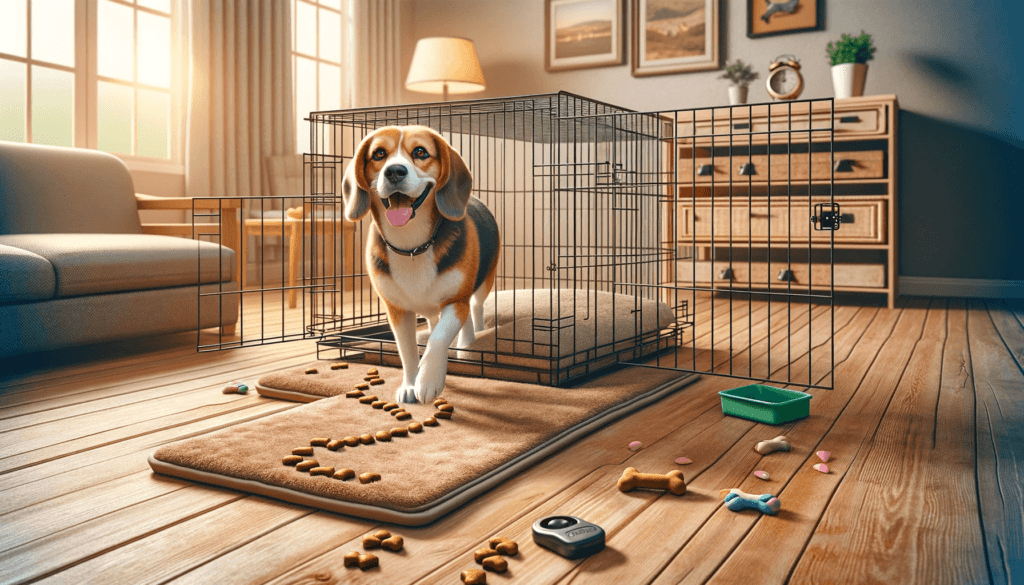

Advancing Dog Crate Training
Improving Crate Training for Your Dog
I’m working on making my dog more comfortable with being in their crate while I’m not home. This means slowly increasing the time they spend alone in their crate. Teaching an adult dog to use a crate or helping a dog who gets anxious when alone is often a gradual process. It’s a kind way to show them that the crate is a safe place, even when I’m not there.
So, embark on this journey of crate training and unlock a world of calm and security for both you and your furry companion.
When you have more than one dog, crate training can get a bit tricky. However, using crates for both house training and daily routines can give each dog their own space. This method also makes it easier to get dogs used to crates for travel, as they learn to see it as a secure spot.
Here’s a breakdown of some advanced strategies I’m using:
| Stage | Activity | Goal |
|---|---|---|
| 1 | Extended Alone Time | Build comfort with solitude |
| 2 | Distance Training | Encourage independence |
| 3 | Random Crating Times | Reduce anxiety triggers |
| 4 | Different Room Setup | Broaden safety association |
| 5 | Preparation for Traveling | Promote relaxation on trips |
By following this structured approach, I’m helping my dog gradually get better at crate training. I aim to make sure they’re comfortable and calm, in any situation.
“In training your dog, each step you take together is a building block towards a trusting and lasting bond. Dog crate training is no exception; it’s about creating a haven for your furry companion, where they can find peace and security.”
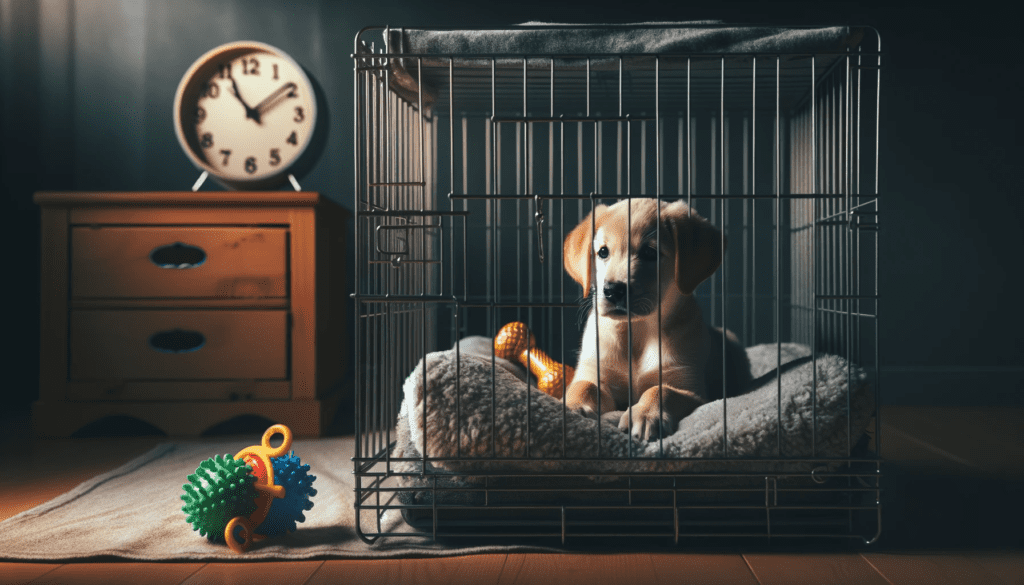

Handling Crate Whining
As I continue training my dog to be comfortable in a crate, I’ve noticed more whining, and I’m working on how to manage it. This is a common challenge, and it’s key to staying on track despite the sad sounds. Dog crate training offers many advantages, such as providing a personal space for your dog and keeping your home safe from accidents.
Here’s my approach to the issue:
- Meeting Basic Needs: I always make sure my dog’s essentials are taken care of before crating—ensuring there’s no whining because of hunger or the need to go outside.
- Creating a Cozy Environment: Making the crate inviting helps my dog feel at home, transforming it into a comfortable retreat.
- Staying Patient: I avoid immediately responding to whining. Staying calm helps teach my dog that making noise isn’t a ticket out.
- Maintaining Routine: Introducing short periods of alone time helps my dog get used to being by themselves without stress.
When crate training a nervous dog, it’s important to be patient and understanding. A common mistake is to react to every whimper, which can reinforce the behavior. I’m learning to tell the difference between cries for attention and real distress. By sticking to these steps, my dog is starting to view the crate as their secure area.
“Consistent, patient training turns the crate into a retreat, not a place of retreat.”
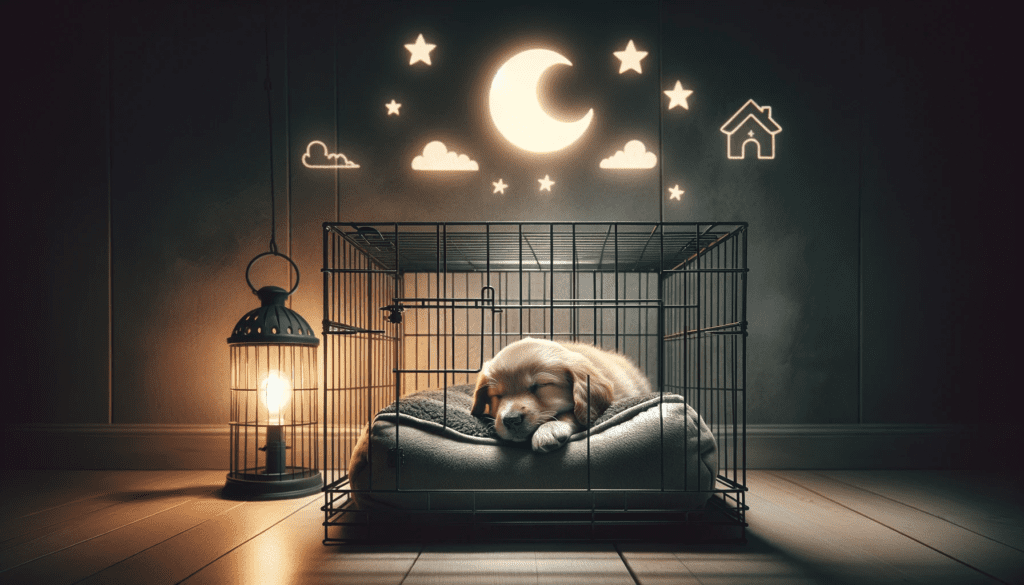

Nighttime Crate Strategies
Dog crate training at night has been a significant part of my experience with my dog, especially in making sure they feel secure and can settle into their new sleep space. Dogs that don’t do well on their own, like those with separation anxiety, need to feel that their crate is a haven. Making sure the crate is free of anything that could hurt them is always a top priority.
Here’s a clear comparison of my dog’s behavior before and after I put in place solid nighttime routines:
| Before Crate Training | After Implementing Nighttime Routines |
|---|---|
| Nervousness and unease | A sense of calm and safety |
| Avoiding the crate | Enjoying their cozy crate |
| Troubled sleep | Restful sleep |
| Whining and anxiety | Peaceful and quiet |
| Scared of being alone | Confident when by themselves |
I made the crate more inviting by adding a soft bed and situating it in a spot that’s quiet but still easy to reach. A small nightlight and the sound of white noise have helped create a peaceful atmosphere. Establishing a regular bedtime routine has made a world of difference in helping my dog see their crate as a place they belong, rather than somewhere they’re sent when they’re alone.
“Transforming a crate from a lonely spot to a cozy retreat has been all about the little details and consistency.”
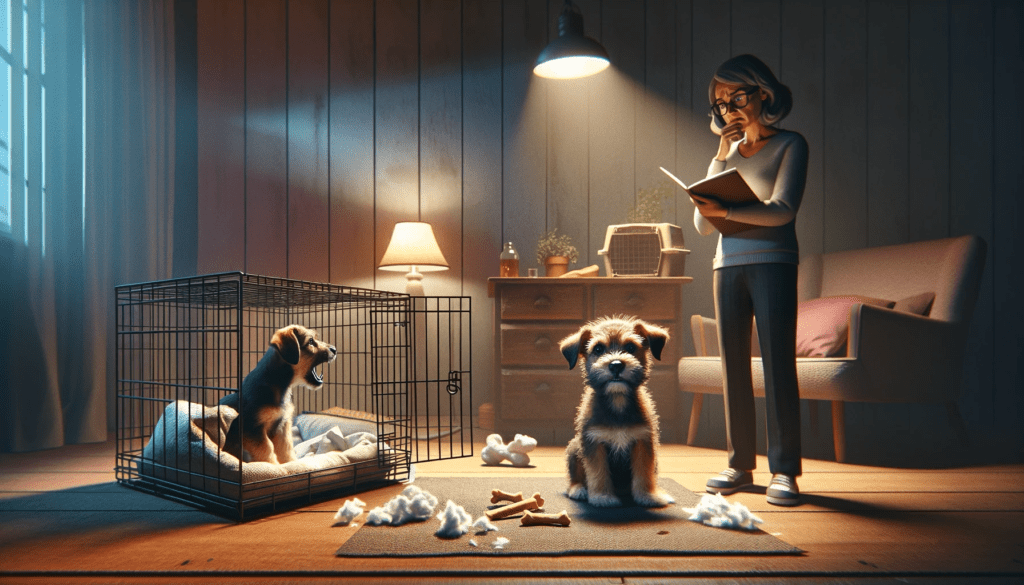

Addressing Crate Challenges
Addressing Crate Challenges
Overcoming crate training obstacles is key to making sure my dog feels secure and at ease during their training. As I’ve worked through common questions and issues, I’ve realized that every dog has unique challenges. Here are some experiences that have helped me stay focused:
- Seeing my dog settle down contently in their crate is incredibly satisfying.
- It can be tough when my dog tries to get out, pushing the durability of my sturdy dog crate to the max.
- I felt so much relief when I figured out how to secure a dog crate properly, which keeps my dog safe.
- It’s rewarding to find and offer other training methods for times when using a crate isn’t the best approach.
Ensuring the safety of your dog during crate training is as crucial as the training itself. Creating a secure and welcoming space within the crate can significantly enhance the experience. Opting for robust locks, selecting a crate of the ideal size, and generously employing praise and treats have led my dog to perceive the crate as their cherished spot. The journey, demanding patience and empathy, has been rewarding, with my dog now feeling content and secure in their crate.
“Finding joy in the simple things, like a dog’s happiness in their crate, reminds us of the bonds we build with our pets.”
Frequently Asked Questions
Should I Crate My Dog at Night?
Going to bed and waking up at the same time keeps my dog’s routine consistent. Using a crate at night helps my dog sleep peacefully, prevents accidents, and aids with house training. It has turned out to be a secure and cozy option for both of us.
“Ensuring your dog feels safe at night is as simple as providing a cozy blanket in their crate,” is a tip for fellow dog owners seeking a peaceful night.
How Long Does It Take for a Dog to Get Used to Crate Training?
The duration required for a dog to become accustomed to crate training varies greatly. While some dogs may be at ease with their crate within a few days, others may need a few weeks. Key to ensuring a seamless adjustment to dog crate training is consistent efforts and the application of positive reinforcement, enhancing the experience for your canine companion.
Consistency is vital; sticking to a regular schedule helps dogs understand what to expect. Pairing crate time with rewards, like treats or their favorite toy, makes the crate a pleasant place for them. As they begin to associate the crate with positive experiences, they’ll start to feel more at home.
Crate training is not only about giving your dog their own space; it’s also about ensuring their safety when you’re not able to supervise them directly. Dogs are den animals by nature, and a crate can become a comfortable, safe spot that’s just theirs.
Remember, patience is your best friend during this process. Each dog has its personality and pace for learning new things. Just like humans, they need time to get used to changes in their routines.
“Training a dog is like learning a new language. You can’t expect to be fluent overnight. It takes time, patience, and lots of practice.”
At What Age Is It Too Late to Crate Train a Dog?
You can teach an older dog to get used to a crate at any age. My own experience with training older dogs shows that with enough dedication and regular practice, they can learn this valuable skill successfully.
Custom Quote: “Age is just a number when it comes to learning – this holds for both humans and dogs alike. Give your dog time and consistent training, and you’ll be surprised at what they can achieve.”
How Many Hours a Day Should I Crate Train My Dog?
When you first start crate training your dog, keep the sessions short, around 1 to 2 hours per day, to make sure your pet is at ease and not stressed. As your dog gets used to the crate, you can gradually extend the time they spend inside.
Custom Quote: “Crate training is about creating a safe space for your dog and building up time spent comfortably—it’s a gradual process that requires patience and consistency.”
